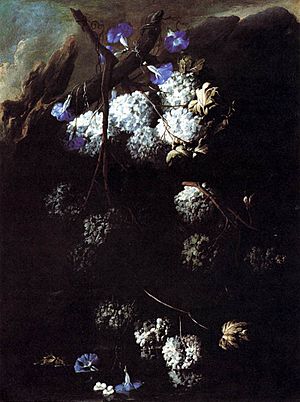Andrea Belvedere facts for kids
Abate Andrea Belvedere (born around 1652, died 1732) was a famous Italian painter from the Baroque period. He was known for his beautiful paintings of flowers and still life.
Contents
Life and Work
Andrea Belvedere was likely born around 1652, not 1646 as some earlier reports suggested. Records show he passed away in Naples on June 27, 1732, when he was about 80 years old.
His Painting Career
Belvedere painted for about twenty years, from 1674 to 1694. During this time, he became quite famous. His reputation led King Charles II of Spain to invite him to work in Spain.
He worked at the Spanish court until 1700. After returning to Naples, Belvedere stopped painting. Instead, he focused completely on theatre work.
His Unique Style
Belvedere developed his own unique painting style. He moved away from the style of Paolo Porpora, who painted still life and flowers in a darker, Caravaggio-like way. Belvedere didn't see these paintings as just "decoration."
He was influenced by another artist, Giuseppe Recco. Belvedere's paintings showed a wonderful sense of light and energy. His work was not overly dramatic, like some other Baroque artists.
Influence on Other Artists
Andrea Belvedere was considered the most important still-life painter in Naples during his time. This was a period when this type of painting was becoming less popular. His original style attracted many younger artists who wanted to learn from him.
When he moved to Spain in 1692, he worked for Charles II of Spain. He helped decorate the Escorial palace with Luca Giordano, who painted the people in the scenes. Some people thought Belvedere copied the Flemish painter Abraham Brueghel, but he was also seen as a rival.
Some of his students or followers included Gasparo Lopez, Baldassare de Caro, Tommaso Realfonso, and Nicola Casissa.
Famous Works
Belvedere created many beautiful paintings, mostly of flowers. Here are some of his notable works:
- Flower Wreath (found in the Museo Correale in Sorrento), painted around 1670.
- Two matching paintings called Bottle with Tulips and Bottle with Carnations (also at the Museo Correale).
- the Peonies (at the Museo Correale), painted between 1670 and 1680.
- Carnations and Tulips and Carnations (at the "Duca di Martina" Museum in Naples).
- Pisces (at the Museum of S. Martino in Naples). This is his only known painting not of flowers, showing the influence of Recco.
- An amazing painting with a branch of elderberry flowers, often called Oriensie (at the Museum of Capodimonte).
- Ducks and Flowers (in Florence, at Palazzo Pitti).
- Flowers, Fruit and Ducks (at the Museo Correale).
- Flowers in the Copper Basin and Flowers, Fruit, Birds (at the Museo Correale), painted between 1690 and 1695.
- Flowers Around a Herm (at the Stibbert Museum in Florence).
See also
 In Spanish: Andrea Belvedere para niños
In Spanish: Andrea Belvedere para niños


